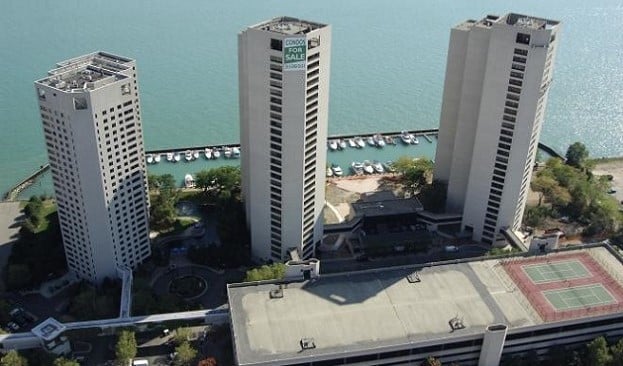
DETROIT—Few places in the nation took a bigger hit during the recession than this metro area. Furthermore, the troubles of the auto industry and the bankruptcy of the Detroit city government generated headlines that had an impact on the region's reputation. But the economic news here turned positive years ago, and the auto industry's revival, along with a downtown renaissance, has given the recovery a broad geographic base. And that has multifamily investors from across the US checking out both suburban and city properties.
“Detroit has a buzz about it,” Peter Benedetto, a Detroit-based senior managing director of Berkadia Commercial Mortgage LLC, tells Globe St.com. Thousands of people are moving in to “be a part of Detroit and the renaissance associated with it.”
But what makes it especially attractive for investors is the lack of new construction, he adds. Historically, there has been only a modest amount of new supply each year, even in the suburbs, and “that has always kept the market tight.” In fact, here even 15-year-old properties can be considered class A.
“There is a lot of interest from out-of-state buyers,” Benedetto says. The bounce back in rents has been a big draw, and even though the values of these properties has increased, the returns are still significantly better than the coastal markets. In the last eight or so deals that Berkadia did in the metro area, about “75% of the winning bids came from out-of-state buyers.”
This appetite for metro area multifamily properties became apparent in about 2011, shortly after the economy had hit bottom, he adds. As a constrained supply market, properties here were able to maintain high occupancy levels, even during the downturn, and investors sensed opportunities. Cap rates were at seven or even eight percent, or premiums of roughly 150 bps over similar properties in the core markets. That gap has narrowed somewhat, and now stands at about 75 bps.
“This is still a suburban market,” he adds, as “the growth in downtown is just starting.” Still, as reported in GlobeSt.com, Berkadia recently brokered the $79.5 million deal for Riverfront Towers, a luxury high-rise apartment community located along the river in downtown Detroit. At $142,729 per-unit, the sale set a new record for a residential complex in the city.
“There is definitely a cachet in officing downtown,” according to Benedetto, a phenomenon that seems to have no end in sight. Although a revival of the downtown office market has been talked about several times, only to later to flame out, “this one is sticking.”
According to a 2015 market study published by Broder & Sachse Real Estate Services, downtown Detroit had a 98% occupancy rate for rentable housing, with neighborhoods such as Grand Circus Park and the CBD at 99%.
Benedetto believes the suburban sales market could remain robust for at least several more years. The region has a fair amount of value-add properties, for example, that have not traded recently. He has noticed that many investors are putting money into local 1970s- and 1980s-era properties that they purchased since 2011. Over the next two or three years, “they are going to be ripe for sale.”

DETROIT—Few places in the nation took a bigger hit during the recession than this metro area. Furthermore, the troubles of the auto industry and the bankruptcy of the Detroit city government generated headlines that had an impact on the region's reputation. But the economic news here turned positive years ago, and the auto industry's revival, along with a downtown renaissance, has given the recovery a broad geographic base. And that has multifamily investors from across the US checking out both suburban and city properties.
“Detroit has a buzz about it,” Peter Benedetto, a Detroit-based senior managing director of Berkadia Commercial Mortgage LLC, tells Globe St.com. Thousands of people are moving in to “be a part of Detroit and the renaissance associated with it.”
But what makes it especially attractive for investors is the lack of new construction, he adds. Historically, there has been only a modest amount of new supply each year, even in the suburbs, and “that has always kept the market tight.” In fact, here even 15-year-old properties can be considered class A.
“There is a lot of interest from out-of-state buyers,” Benedetto says. The bounce back in rents has been a big draw, and even though the values of these properties has increased, the returns are still significantly better than the coastal markets. In the last eight or so deals that Berkadia did in the metro area, about “75% of the winning bids came from out-of-state buyers.”
This appetite for metro area multifamily properties became apparent in about 2011, shortly after the economy had hit bottom, he adds. As a constrained supply market, properties here were able to maintain high occupancy levels, even during the downturn, and investors sensed opportunities. Cap rates were at seven or even eight percent, or premiums of roughly 150 bps over similar properties in the core markets. That gap has narrowed somewhat, and now stands at about 75 bps.
“This is still a suburban market,” he adds, as “the growth in downtown is just starting.” Still, as reported in GlobeSt.com, Berkadia recently brokered the $79.5 million deal for Riverfront Towers, a luxury high-rise apartment community located along the river in downtown Detroit. At $142,729 per-unit, the sale set a new record for a residential complex in the city.
“There is definitely a cachet in officing downtown,” according to Benedetto, a phenomenon that seems to have no end in sight. Although a revival of the downtown office market has been talked about several times, only to later to flame out, “this one is sticking.”
According to a 2015 market study published by Broder & Sachse Real Estate Services, downtown Detroit had a 98% occupancy rate for rentable housing, with neighborhoods such as Grand Circus Park and the CBD at 99%.
Benedetto believes the suburban sales market could remain robust for at least several more years. The region has a fair amount of value-add properties, for example, that have not traded recently. He has noticed that many investors are putting money into local 1970s- and 1980s-era properties that they purchased since 2011. Over the next two or three years, “they are going to be ripe for sale.”
© Touchpoint Markets, All Rights Reserved. Request academic re-use from www.copyright.com. All other uses, submit a request to [email protected]. For more inforrmation visit Asset & Logo Licensing.








